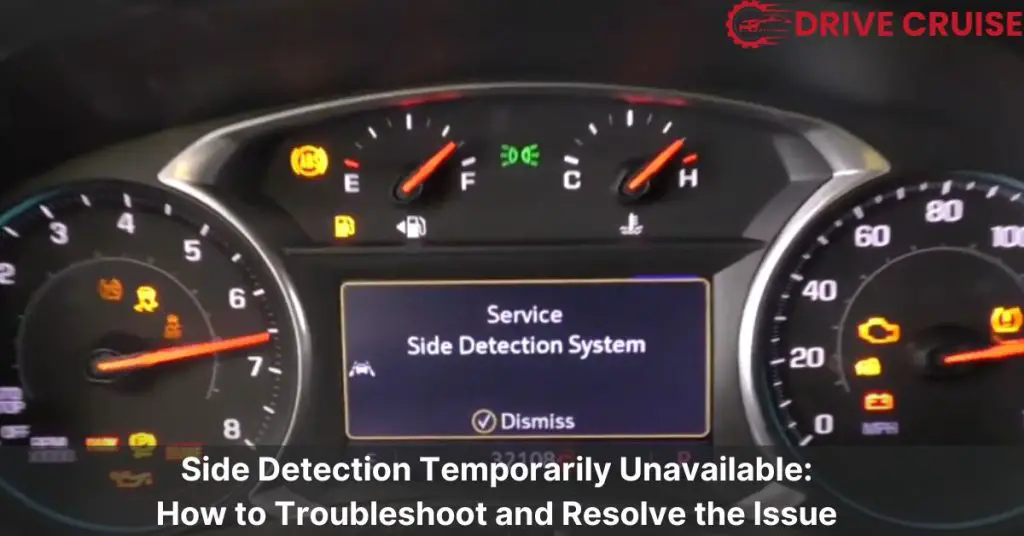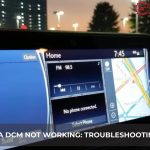We’ve all been there—cruising down the highway, music up, enjoying the drive when suddenly a dashboard light flickers on: “Side Detection Temporarily Unavailable.” It’s a moment that can raise eyebrows and pulse rates. But what does it really mean, and why does it happen?
In today’s tech-savvy world, our vehicles are more than just metal on wheels. They’re equipped with advanced safety features designed to make our journeys safer and more comfortable. However, like all technology, they’re not immune to hiccups. Let’s dive into the nitty-gritty of this common yet often misunderstood alert, breaking down its causes and how we can address it. After all, understanding our car’s language is the first step to a smoother, worry-free ride.
Understanding “Side Detection Temporarily Unavailable”
Moving forward from the understanding that modern vehicles come packed with advanced safety features, it’s crucial to dive deeper into what triggers the “Side Detection Temporarily Unavailable” alert and its implications. This particular notice informs the driver when the side detection system, responsible for monitoring the vehicle’s blind spots, is not functioning correctly.
First, common causes of this alert include:
- Obstructions on Sensors: Dirt, ice, or debris can block the sensors, preventing them from scanning the vehicle’s surroundings accurately.
- Adverse Weather Conditions: Heavy rain, snow, or fog can interfere with sensor functionality, leading to temporary unavailability.
- System Overload: Occasionally, an overwhelming amount of information processed by the vehicle’s computer systems can cause temporary failures.
- Damage to the Vehicle: Accidents or impact damage that affects the sensors or their alignment can trigger the alert.
Understanding these triggers helps in addressing the issue more effectively. If the alert activates, taking simple steps can sometimes resolve the problem:
- Inspect the Sensors: If safe to do so, stop the vehicle and examine the sensors for any visible obstructions.
- Wait for Clear Weather: If adverse conditions are the cause, the system may resume normal operation once the weather improves.
- Schedule a Diagnostic Check: Persistent issues or alerts necessitate professional examination to ensure the safety systems function optimally.
These approaches underscore the importance of regular maintenance and the need for drivers to familiarize themselves with their vehicle’s technology. Recognizing the reasons behind the “Side Detection Temporarily Unavailable” alert empowers drivers to maintain their safety features effectively, ensuring a safer driving experience for everyone on the road.
Impact on Vehicle Safety
Moving on from understanding what triggers the “Side Detection Temporarily Unavailable” alert and how to address it, it’s crucial to discuss the implications this alert has on vehicle safety. Modern vehicles come equipped with advanced safety systems, including side detection technology that plays a fundamental role in preventing side-swipe accidents and ensuring safe lane changes. When this technology becomes temporarily unavailable, drivers find themselves without an active alert system for objects in their blind spots, which significantly increases the risk of accidents.
First, the immediate impact is on the driver’s situational awareness. Drivers, especially those who’ve grown reliant on technology for safety cues, might miss vehicles or obstacles in their blind spot, leading to potential collisions. The absence of side detection alerts forces drivers to rely solely on mirrors and direct vision, which can be challenging in heavy traffic or at high speeds.
Second, the effectiveness of adjacent safety systems may diminish. For instance, some vehicles integrate side detection with lane-keeping assist, where the system not only alerts the driver about objects in blind spots but also actively prevents the vehicle from changing lanes in a dangerous situation. With side detection down, these preventive measures are compromised.
Third, the overall safety rating of a vehicle, as perceived by the driver, decreases. Confidence in a vehicle’s ability to protect its occupants is paramount. When a critical component of the safety system is flagged as unavailable, it may cause concern or even anxiety for drivers and passengers, affecting the driving experience.
To mitigate these impacts, drivers should increase their vigilance and revert to more traditional driving practices, like manually checking blind spots more frequently. Additionally, addressing the cause of the alert promptly ensures that the vehicle’s safety systems are fully functional, minimizing the duration and impact of the alert on vehicle safety. Remember, maintenance and familiarity with the vehicle’s technology are key in ensuring these safety systems operate effectively, maintaining the safety net they provide during daily commutes and longer journeys alike.
Troubleshooting Steps
After understanding the reasons behind the “Side Detection Temporarily Unavailable” alert and its impact on vehicle safety, it’s crucial to know how to address this issue promptly. Here, we’ll guide you through some basic troubleshooting steps to help restore your vehicle’s side detection capabilities.
- Check for Obstructions: First, inspect the sensors located on the sides of your vehicle. Dirt, ice, or debris can block sensors, leading to alerts. Cleaning the sensors thoroughly can often resolve the issue.
- Restart the Vehicle: Sometimes, a simple restart can reset the system and eliminate temporary glitches. Turn off your vehicle for a minute before restarting it to see if the alert clears.
- Inspect for Damage: Look for any visible signs of damage to the sensors or surrounding areas. If you find any, it’s likely the cause of the malfunction and requires professional repair.
- Review Recent Vehicle Repairs: If you’ve recently had work done on your vehicle, ensure nothing was disconnected or improperly reassembled. Sometimes, side detection sensors can be inadvertently affected during unrelated repairs.
- Consult the Vehicle Manual: Your vehicle’s manual may have specific instructions or additional troubleshooting steps for the side detection system. Reviewing this can provide model-specific guidance.
- Update Software: In some cases, the issue might stem from outdated software. Check if there are any available software updates for your vehicle’s safety systems and install them.
- Professional Diagnostic: If the alert persists despite these steps, it’s time for a professional diagnostic. A certified technician can use advanced tools to pinpoint the problem and recommend the best course of action.
By following these steps, we can tackle the “Side Detection Temporarily Unavailable” alert effectively, ensuring our vehicle’s safety systems are fully functional and reducing the risk to our safety.
Preventive Measures
Following our exploration of the causes, solutions, and impacts of the “Side Detection Temporarily Unavailable” alert, it’s clear that preventing this alert is just as crucial as knowing how to respond to it. Here, we’ll outline key preventive measures to help ensure your vehicle’s side detection technology remains in optimal condition.
- Regular Maintenance Appointments: Schedule and keep regular maintenance appointments for your vehicle. During these appointments, mechanics can check the side detection sensors along with other safety systems, ensuring they’re clean, damage-free, and functioning correctly.
- Self-Inspection Routines: Develop a routine to regularly inspect the exterior of your vehicle, focusing on the areas around the side detection sensors. Remove any dirt, mud, snow, or ice that could obstruct the sensors’ ability to “see.”
- Safe Parking Practices: When parking, choose spots that reduce the risk of damage to your vehicle’s sides, such as end spots or away from tight spaces. This can minimize the likelihood of damage to the sensors from minor collisions or scrapes.
- Staying Informed: Keep up with the latest software updates for your vehicle. Manufacturers may release updates that improve the functionality and reliability of side detection systems. Check your manufacturer’s website or contact your dealer to stay informed about any available updates.
- Driving Carefully in Adverse Conditions: Recognize that bad weather conditions, like heavy rain, snow, or fog, can affect the performance of side detection systems. In such conditions, increase your vigilance and rely more on traditional driving practices, such as manually checking blind spots.
- Professional Consultations: If you notice your side detection system acting unusually, even without an alert, consult with a professional technician. Early detection of potential issues can prevent more serious problems later.
By incorporating these preventive measures into your regular vehicle maintenance and driving habits, you’ll greatly reduce the chances of encountering a “Side Detection Temporarily Unavailable” alert. More importantly, these steps will help maintain the overall safety and functionality of your vehicle’s safety systems, offering peace of mind on the road.
Real-World Experiences
In our journey to understand the “Side Detection Temporarily Unavailable” alert better, we’ve come across various real-world experiences from drivers. These stories not only highlight the commonality of the issue but also serve as a valuable resource for understanding its impact and managing it effectively.
First, many drivers report encountering this alert during extreme weather conditions, such as heavy snowfall or rain. For instance, a driver in Minnesota noticed the alert consistently popping up during a severe snowstorm, which inhibited the side detection system’s sensors. After the weather cleared and the vehicle was cleaned, the system resumed normal operation, underscoring the importance of sensor maintenance in adverse weather.
Second, parking-related incidents appear frequently in discussions. A case in point involves a driver from California who found that after parking next to a high curb, the alert was triggered, possibly due to the vehicle’s angle affecting the sensors’ ability to function properly. Simple repositioning of the vehicle resolved the issue, highlighting the need for careful parking to avoid sensor obstruction.
Lastly, software update stories are quite enlightening. Several drivers have shared their experiences with the alert ceasing to appear after receiving a software update, suggesting that keeping the vehicle’s software up-to-date is crucial for system functionality.
These accounts, varying from weather challenges to software solutions, illustrate the multifaceted nature of dealing with the “Side Detection Temporarily Unavailable” alert. They also reinforce the strategies mentioned earlier, like regular maintenance and staying informed about software updates, as keys to minimizing the alert’s occurrence. By sharing these experiences, we aim to create a community of informed drivers who feel equipped to tackle this issue head-on, ensuring their safety and the safety of others on the road.
Conclusion
We’ve walked through the maze of “Side Detection Temporarily Unavailable” together, uncovering the why’s and how’s behind it. It’s clear that staying ahead with regular maintenance and being in tune with our vehicle’s tech can make a huge difference. Let’s not forget the power of understanding the conditions that trigger this alert and how a bit of awareness about software updates can keep us rolling safely. By embracing these insights and tips, we’re not just addressing a temporary glitch; we’re steering towards a smoother, safer journey every time we hit the road. So here’s to fewer alerts and more confident driving ahead!
Related Posts:







